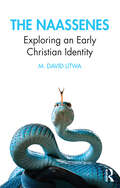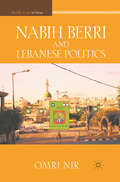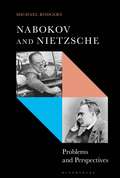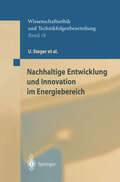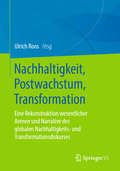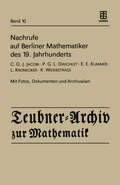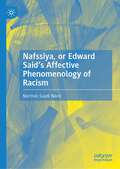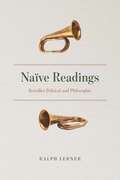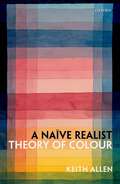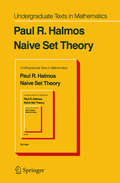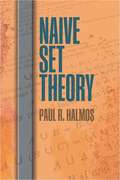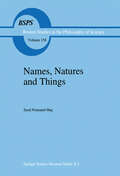- Table View
- List View
The Naassenes: Exploring an Early Christian Identity
by M. LitwaThis volume offers an accessible investigation of the Naassene discourse embedded in the anonymous Refutation of All Heresies (completed about 222 CE), in order to understand the theology and ritual life of the Naassene Christian movement in the late second and early third centuries CE. The work provides basic data on the date, genre, and provenance of the Naassene discourse as summarized by the author of the Refutation (or Refutator). It also offers an analysis of the Refutator’s sources and working methods, an analysis which allows for a full reconstruction of the original Naassene discourse. The book then turns to major aspects of Naassene Christianity: its intense engagement with Hellenic myth and “mysteries,” its biblical sources, its cosmopolitan hermeneutics, its snake symbology, as well as its distinctive approach to baptism, hymns, and celibacy. A concluding chapter outlines all we can securely reconstruct about the Naassene Christian movement in terms of its social identity and place in the larger field of early Christianity and ancient Mediterranean religions more broadly. The Naassenes: Exploring an Early Christian Identity is suitable for students, scholars, and general readers interested in Early Christianity, Gnostic and Nag Hammadi Studies, Classics, and Ancient Philosophy, as well as hermeneutical issues like allegory and intertextuality.
The Naassenes: Exploring an Early Christian Identity
by M. LitwaThis volume offers an accessible investigation of the Naassene discourse embedded in the anonymous Refutation of All Heresies (completed about 222 CE), in order to understand the theology and ritual life of the Naassene Christian movement in the late second and early third centuries CE. The work provides basic data on the date, genre, and provenance of the Naassene discourse as summarized by the author of the Refutation (or Refutator). It also offers an analysis of the Refutator’s sources and working methods, an analysis which allows for a full reconstruction of the original Naassene discourse. The book then turns to major aspects of Naassene Christianity: its intense engagement with Hellenic myth and “mysteries,” its biblical sources, its cosmopolitan hermeneutics, its snake symbology, as well as its distinctive approach to baptism, hymns, and celibacy. A concluding chapter outlines all we can securely reconstruct about the Naassene Christian movement in terms of its social identity and place in the larger field of early Christianity and ancient Mediterranean religions more broadly. The Naassenes: Exploring an Early Christian Identity is suitable for students, scholars, and general readers interested in Early Christianity, Gnostic and Nag Hammadi Studies, Classics, and Ancient Philosophy, as well as hermeneutical issues like allegory and intertextuality.
Nabih Berri and Lebanese Politics (Middle East in Focus)
by O. NirNabih Barri is a key figure in the Lebanese and Shi'ite politics for the last three decades. As the leader of the Shi'ite Amal movement since 1980 and as the Lebanese Speaker since 1992, Barri played a major role in all political events and processes in Lebanon between the early 1980's and today, including the current severe Lebanese crisis.
Nabokov and Nietzsche: Problems and Perspectives
by Michael RodgersNabokov and Nietzsche: Problems and Perspectives addresses the many knotted issues in the work of Vladimir Nabokov – Lolita's moral stance, Pnin's relationship with memory, Pale Fire's ambiguous internal authorship – that often frustrate interpretation. It does so by arguing that the philosophy of Friedrich Nietzsche, as both a conceptual instrument and a largely unnoticed influence on Nabokov himself, can help to untie some of these knots. The study addresses the fundamental problems in Nabokov's writing that make his work perplexing, mysterious and frequently uneasy rather than simply focusing on the literary puzzles and games that, although inherent, do not necessarily define his body of work. Michael Rodgers shows that Nietzsche's philosophy provides new, but not always palatable, perspectives in order to negotiate interpretative impasses, and that the uneasy aspects of Nabokov's work offer the reader manifold rewards.
Nabokov and Nietzsche: Problems and Perspectives
by Michael RodgersNabokov and Nietzsche: Problems and Perspectives addresses the many knotted issues in the work of Vladimir Nabokov – Lolita's moral stance, Pnin's relationship with memory, Pale Fire's ambiguous internal authorship – that often frustrate interpretation. It does so by arguing that the philosophy of Friedrich Nietzsche, as both a conceptual instrument and a largely unnoticed influence on Nabokov himself, can help to untie some of these knots. The study addresses the fundamental problems in Nabokov's writing that make his work perplexing, mysterious and frequently uneasy rather than simply focusing on the literary puzzles and games that, although inherent, do not necessarily define his body of work. Michael Rodgers shows that Nietzsche's philosophy provides new, but not always palatable, perspectives in order to negotiate interpretative impasses, and that the uneasy aspects of Nabokov's work offer the reader manifold rewards.
Nabokov and the Question of Morality: Aesthetics, Metaphysics, and the Ethics of Fiction
by Michael Rodgers Susan Elizabeth SweeneyThe first collection to address the vexing issue of Nabokov’s moral stances, this book argues that he designed his novels and stories as open-ended ethical problems for readers to confront. In a dozen new essays, international Nabokov scholars tackle those problems directly while addressing such questions as whether Nabokov was a bad reader, how he defined evil, if he believed in God, and how he constructed fictional works that led readers to become aware of their own moral positions. In order to elucidate his engagement with aesthetics, metaphysics, and ethics, Nabokov and the Question of Morality explores specific concepts in the volume’s four sections: “Responsible Reading,” “Good and Evil,” “Agency and Altruism,” and “The Ethics of Representation.” By bringing together fresh insights from leading Nabokovians and emerging scholars, this book establishes new interdisciplinary contexts for Nabokov studies and generates lively readings of works from his entire career.
Nachhaltige Entwicklung und Innovation im Energiebereich (Ethics of Science and Technology Assessment #18)
by U. Steger W. Achterberg K. Blok H. Bode W. Frenz C. Gather G. Hanekamp D. Imboden M. Jahnke M. Kost R. Kurz H.G. Nutzinger Th. ZiesemerFast alle Energieszenarien stützen sich auf Trends, die auf ein enormes Wachstum des Energiebedarfs in den nächsten Jahrzehnten hinauslaufen. Auf internationalen Konferenzen beschäftigt man sich indes mit dem Gegenteil: einer massiven Verringerung der Treibhausgasemissionen, vor allem der durch den Verbrauch von Energie verursachten CO2-Emissionen. Experten verweisen auch auf das politische Risiko der Abhängigkeit vom Erdöl und die Erschöpflichkeit von Ressourcen. Wie soll diese Kluft überbrückt werden? Wie lässt sich das bestehende Energiesystem nachhaltiger gestalten? Die Hoffnungen richten sich vor allem auf den technischen Fortschritt und Innovationen. Bislang liegen jedoch keine konkreten Vorschläge vor, inwieweit Innovationen tatsächlich dazu beitragen können, einen ständig wachsenden Energieverbrauch mit den Limitierungen im Hinblick auf die Ressourcenverfügbarkeit und die Umwelt sowie den strukturellen Anforderungen an ein Energiesystem in Einklang zu bringen. Die vorliegende Studie führt wirtschaftswissenschaftliche, juristische, naturwissenschaftliche und philosophische Kompetenzen im Hinblick auf derartige Vorschläge zusammen. Aufbauend auf einer soliden Rekonstruktion der mitunter verwirrenden Vielfalt der Begriffe werden Beurteilungen des bestehenden Energiesystems vorgelegt und Nachhaltigkeitspotenziale aufgezeigt. Die strategisch gebündelten Handlungsempfehlungen berücksichtigen die vielfältigen Zielkonflikte umwelt- und energiepolitischen Handelns und werden durch Implementierungsvorschläge ergänzt.
Nachhaltigkeit, Postwachstum, Transformation: Eine Rekonstruktion wesentlicher Arenen und Narrative des globalen Nachhaltigkeits- und Transformationsdiskurses
by Ulrich RoosDer Band versammelt zentrale Befunde abgeschlossener Forschungsarbeiten zur Frage der Entwicklung des globalen Nachhaltigkeitsdiskurses. Welche Narrative, Strategien, Ziele und Werte bestimmen den Kampf um Definition und Ausgestaltung nachhaltiger Politik? Welche Transformationsprozesse sind erkennbar, werden initiiert, gefordert oder bekämpft? Und welche Bedeutung kommt hierbei wirtschaftswissenschaftlichen Konzepten zu Wirkung und Relevanz von Wirtschaftswachstum sowie den hieran geäußerten Kritiken zu?Um diese Fragen zu beantworten, werden verschiedene Arenen des deutschsprachigen Nachhaltigkeitsdiskurses – Arbeit, Bildung, „Entwicklung“, Ethik, Transformation – detailliert rekonstruiert, um auf Grundlage der daraus resultierenden Gesamtschau des ökologisch-ökonomisch-politischen Systems die gegenwärtig hegemonialen Handlungsregeln und -logiken zu erkennen und kritisch zu reflektieren.
Nachrufe auf Berliner Mathematiker des 19. Jahrhunderts: C.G.J. Jacobi - P.G.L. Dirichlet - E.E. Kummer - L. Kronecker - K. Weierstrass (Teubner-Archiv zur Mathematik #10)
by H. ReichardtMit den hier abgedruckten klassischen biographischen Texten der Autoren Dirichlet, Kummer, Hensel, Frobenius und Hilbert werden dem Leser Einblicke in Leben und Werk herausragender Wissenschaftler eröffnet. Außerdem erhält er authentische Informationen über den Wissenschaftsbereich des 19. Jahrhunderts. Fotos und bisher unveröffentlichte Archivalien komplettieren diesen von H. Reichardt, dem langjährigen Direktor an den Mathematischen Instituten der Humboldt-Universität Berlin sowie der Akademie der Wissenschaften, herausgegebenen Band.
El nacimiento de la tragedia
by Friedrich NietzscheEl nacimiento de la tragedia es la erupción armónica de una larga e intensa formación intelectual y espiritual de un joven Nietzsche dominado por la belleza y la honestidad. En este libro, donde confluyen la pasión por la música, la búsqueda de la verdad y la admiración por el mundo clásico, corren, estrepitosas y fulgurantes, como ríos de lava, imágenes y concepciones hasta entonces nunca vistas ni oídas; un pensamiento que, descubriendo lo horrible y lo cruel de la naturaleza -su aspecto dionisíaco-, junto con su necesidad de redención en la apariencia, cautivó a miles de espíritus atentos al drama de la existencia desde su publicación hasta nuestro momento presente.
Nafssiya, or Edward Said's Affective Phenomenology of Racism
by Norman Saadi NikroThis book adapts the Arabic term nafsiyya to trace the phenomenological contours of Edward Said’s analysis of the affective dimensions of colonial and imperial racism. Reflecting on what he called his “colonial education,” Said rendered his Palestinian/Arab background and experience of racism an enabling component of his academic work. The argument focuses on his “personal dimension” section in his introduction to his famous volume Orientalism, discussing key notions of Said’s oeuvre—such as ‘elaboration,’ ‘circumstance,’ ‘humanism,’ ‘worldliness,’ ‘inventory,’ and ‘critical consciousness.’ Providing a lengthy study of his earlier and somewhat neglected Beginnings: Intention and Method, the book discusses the significance of the style of the essay as a key component of what the author calls Said’s interventionist brand of scholarship. The final chapter outlines how Said’s oeuvre can be situated in a genealogy of a radical phenomenology of racism that emerged from the colonies.
Nähe, Distanz und Anerkennung in pädagogischen Beziehungen: Rekonstruktionen zum Lehrerhabitus und Möglichkeiten der Professionalisierung (Studien zur Schul- und Bildungsforschung #80)
by Marlene KowalskiMarlene Kowalski arbeitet in ihrer Studie die verinnerlichten Haltungen von Lehrkräften zur Gestaltung der Beziehung zu ihren Schülerinnen und Schülern heraus. Ihr Ausgangspunkt ist die Aufdeckung der Fälle sexualisierter Gewalt in pädagogischen Einrichtungen und die grundlegende Brisanz von Nähe in der pädagogischen Beziehung. Über die empirische Rekonstruktion von beruflichen Habitusformationen und Handlungsmustern der Lehrkräfte beleuchtet die Autorin umfassend das Spannungsfeld von Nähe, Distanz und Anerkennung im Handlungsfeld Schule und reichert ihre Erkenntnisse theoretisch an.
Naissance et développement du vitalisme en France de la deuxième moitié du XVIIIe siècle à la fin du Premier Empire (Oxford University Studies in the Enlightenment #381)
by Roselyne ReyDepuis ses origines au milieu du dix-huitième siècle jusqu’au milieu du dix-neuvième, le vitalisme a été un élément important de la pensée européenne en général, et de la pensée médicale en particulier. Cependant, sa mauvaise réputation – il était considéré par les médecins et les biologistes comme une théorie obscure et métaphysique – a largement découragé les historiens des idées d’en faire une étude suivie. L’historie du vitalisme français, grand sujet d’histoire intellectuelle et sociale, restait à faire.Ce volume, écrit par la regrettée Roselyne Rey, est fondé sur une étude précise de nombreux textes, toujours replacés dans un contexte intellectuel général, ce qui met en évidence des aspects souvent ignorés de la pensée vitaliste. Le travail de R. Rey apporte des éclairages neufs sur l’histoire des sciences médicales au dix-huitième siècle, en particulier sur le terrain dans lequel les différentes theories se sont développées et sur leurs protagonistes, théories qui sont une des bases de l’Encyclopédie et de la philosophie des Lumières.
Naïve Readings: Reveilles Political and Philosophic
by Ralph LernerOne sure fact of humanity is that we all cherish our opinions and will often strongly resist efforts by others to change them. Philosophers and politicians have long understood this, and whenever they have sought to get us to think differently they have often resorted to forms of camouflage that slip their unsettling thoughts into our psyche without raising alarm. In this fascinating examination of a range of writers and thinkers, Ralph Lerner offers a new method of reading that detects this camouflage and offers a way toward deeper understandings of some of history’s most important—and most concealed—messages. Lerner analyzes an astonishing diversity of writers, including Francis Bacon, Benjamin Franklin, Edward Gibbon, Judah Halevi, Thomas Jefferson, Abraham Lincoln, Moses Maimonides, and Alexis de Tocqueville. He shows that by reading their words slowly and naïvely, with wide-open eyes and special attention for moments of writing that become self-conscious, impassioned, or idiosyncratic, we can begin to see a pattern that illuminates a thinker’s intent, new messages purposively executed through indirect means. Through these experimental readings, Lerner shows, we can see a deep commonality across writers from disparate times and situations, one that finds them artfully challenging others to reject passivity and fatalism and start thinking afresh.
Naïve Readings: Reveilles Political and Philosophic
by Ralph LernerOne sure fact of humanity is that we all cherish our opinions and will often strongly resist efforts by others to change them. Philosophers and politicians have long understood this, and whenever they have sought to get us to think differently they have often resorted to forms of camouflage that slip their unsettling thoughts into our psyche without raising alarm. In this fascinating examination of a range of writers and thinkers, Ralph Lerner offers a new method of reading that detects this camouflage and offers a way toward deeper understandings of some of history’s most important—and most concealed—messages. Lerner analyzes an astonishing diversity of writers, including Francis Bacon, Benjamin Franklin, Edward Gibbon, Judah Halevi, Thomas Jefferson, Abraham Lincoln, Moses Maimonides, and Alexis de Tocqueville. He shows that by reading their words slowly and naïvely, with wide-open eyes and special attention for moments of writing that become self-conscious, impassioned, or idiosyncratic, we can begin to see a pattern that illuminates a thinker’s intent, new messages purposively executed through indirect means. Through these experimental readings, Lerner shows, we can see a deep commonality across writers from disparate times and situations, one that finds them artfully challenging others to reject passivity and fatalism and start thinking afresh.
Naïve Readings: Reveilles Political and Philosophic
by Ralph LernerOne sure fact of humanity is that we all cherish our opinions and will often strongly resist efforts by others to change them. Philosophers and politicians have long understood this, and whenever they have sought to get us to think differently they have often resorted to forms of camouflage that slip their unsettling thoughts into our psyche without raising alarm. In this fascinating examination of a range of writers and thinkers, Ralph Lerner offers a new method of reading that detects this camouflage and offers a way toward deeper understandings of some of history’s most important—and most concealed—messages. Lerner analyzes an astonishing diversity of writers, including Francis Bacon, Benjamin Franklin, Edward Gibbon, Judah Halevi, Thomas Jefferson, Abraham Lincoln, Moses Maimonides, and Alexis de Tocqueville. He shows that by reading their words slowly and naïvely, with wide-open eyes and special attention for moments of writing that become self-conscious, impassioned, or idiosyncratic, we can begin to see a pattern that illuminates a thinker’s intent, new messages purposively executed through indirect means. Through these experimental readings, Lerner shows, we can see a deep commonality across writers from disparate times and situations, one that finds them artfully challenging others to reject passivity and fatalism and start thinking afresh.
Naïve Readings: Reveilles Political and Philosophic
by Ralph LernerOne sure fact of humanity is that we all cherish our opinions and will often strongly resist efforts by others to change them. Philosophers and politicians have long understood this, and whenever they have sought to get us to think differently they have often resorted to forms of camouflage that slip their unsettling thoughts into our psyche without raising alarm. In this fascinating examination of a range of writers and thinkers, Ralph Lerner offers a new method of reading that detects this camouflage and offers a way toward deeper understandings of some of history’s most important—and most concealed—messages. Lerner analyzes an astonishing diversity of writers, including Francis Bacon, Benjamin Franklin, Edward Gibbon, Judah Halevi, Thomas Jefferson, Abraham Lincoln, Moses Maimonides, and Alexis de Tocqueville. He shows that by reading their words slowly and naïvely, with wide-open eyes and special attention for moments of writing that become self-conscious, impassioned, or idiosyncratic, we can begin to see a pattern that illuminates a thinker’s intent, new messages purposively executed through indirect means. Through these experimental readings, Lerner shows, we can see a deep commonality across writers from disparate times and situations, one that finds them artfully challenging others to reject passivity and fatalism and start thinking afresh.
A Naïve Realist Theory of Colour
by Keith AllenA Naïve Realist Theory of Colour defends the view that colours are mind-independent properties of things in the environment, that are distinct from properties identified by the physical sciences. This view stands in contrast to the long-standing and wide-spread view amongst philosophers and scientists that colours don't really exist - or at any rate, that if they do exist, then they are radically different from the way that they appear. It is argued that a naïve realist theory of colour best explains how colours appear to perceiving subjects, and that this view is not undermined either by reflecting on variations in colour perception between perceivers and across perceptual conditions, or by our modern scientific understanding of the world. A Naïve Realist Theory of Colour also illustrates how our understanding of what colours are has far-reaching implications for wider questions about the nature of perceptual experience, the relationship between mind and world, the problem of consciousness, the apparent tension between common sense and scientific representations of the world, and even the very nature and possibility of philosophical inquiry.
A Naïve Realist Theory of Colour
by Keith AllenA Naïve Realist Theory of Colour defends the view that colours are mind-independent properties of things in the environment, that are distinct from properties identified by the physical sciences. This view stands in contrast to the long-standing and wide-spread view amongst philosophers and scientists that colours don't really exist - or at any rate, that if they do exist, then they are radically different from the way that they appear. It is argued that a naïve realist theory of colour best explains how colours appear to perceiving subjects, and that this view is not undermined either by reflecting on variations in colour perception between perceivers and across perceptual conditions, or by our modern scientific understanding of the world. A Naïve Realist Theory of Colour also illustrates how our understanding of what colours are has far-reaching implications for wider questions about the nature of perceptual experience, the relationship between mind and world, the problem of consciousness, the apparent tension between common sense and scientific representations of the world, and even the very nature and possibility of philosophical inquiry.
Naive Set Theory (Undergraduate Texts in Mathematics)
by P. R. HalmosEvery mathematician agrees that every mathematician must know some set theory; the disagreement begins in trying to decide how much is some. This book contains my answer to that question. The purpose of the book is to tell the beginning student of advanced mathematics the basic set theoretic facts of life, and to do so with the minimum of philosophical discourse and logical formalism. The point of view throughout is that of a prospective mathematician anxious to study groups, or integrals, or manifolds. From this point of view the concepts and methods of this book are merely some of the standard mathematical tools; the expert specialist will find nothing new here. Scholarly bibliographical credits and references are out of place in a purely expository book such as this one. The student who gets interested in set theory for its own sake should know, however, that there is much more to the subject than there is in this book. One of the most beautiful sources of set-theoretic wisdom is still Hausdorff's Set theory. A recent and highly readable addition to the literature, with an extensive and up-to-date bibliography, is Axiomatic set theory by Suppes.
Naive Set Theory (Dover Books on Mathematics)
by Paul R. HalmosThis classic by one of the twentieth century's most prominent mathematicians offers a concise introduction to set theory. Suitable for advanced undergraduates and graduate students in mathematics, it employs the language and notation of informal mathematics. There are very few displayed theorems; most of the facts are stated in simple terms, followed by a sketch of the proof. Only a few exercises are designated as such since the book itself is an ongoing series of exercises with hints. The treatment covers the basic concepts of set theory, cardinal numbers, transfinite methods, and a good deal more in 25 brief chapters.
Naked: The Dark Side of Shame and Moral Life
by Krista K. ThomasonWe know shame can be a morally valuable emotion that helps us to realize when we fail to be the kinds of people we aspire to be. We feel shame when we fail to live up to the norms, standards, and ideals that we value as part of a virtuous life. But the lived reality of shame is far more complex and far darker than this -- the gut-level experience of shame that has little to do with failing to reach our ideals. We feel shame viscerally about nudity, sex, our bodies, and weaknesses or flaws that we can't control. Shame can cause self-destructive and violent behavior, and chronic shame can cause painful psychological damage. Is shame a valuable moral emotion, or would we be better off without it? In Naked, Krista K. Thomason takes a hard look at the reality of shame. The experience of it, she argues, involves a tension between identity and self-conception: namely, what causes me shame both overshadows me (my self-conception) and yet is me (my identity). We are liable to feelings of shame because we are not always who we take ourselves to be. Thomason extends her thought-provoking analysis to our current social and political landscape: shaming has increased dramatically because of the proliferation of social media platforms. And although these online shaming practices can be used in harmful ways, they can also root out those who express racist and sexist views, and enable marginalized groups to confront oppression. Is more and continued shaming therefore better, and is there moral promise in using shame in this way? Thomason grapples with these and numerous other questions. Her account of shame makes sense of its good and bad features, its numerous gradations and complexity, and ultimately of its essential place in our moral lives.
Naked: The Dark Side of Shame and Moral Life
by Krista K. ThomasonWe know shame can be a morally valuable emotion that helps us to realize when we fail to be the kinds of people we aspire to be. We feel shame when we fail to live up to the norms, standards, and ideals that we value as part of a virtuous life. But the lived reality of shame is far more complex and far darker than this -- the gut-level experience of shame that has little to do with failing to reach our ideals. We feel shame viscerally about nudity, sex, our bodies, and weaknesses or flaws that we can't control. Shame can cause self-destructive and violent behavior, and chronic shame can cause painful psychological damage. Is shame a valuable moral emotion, or would we be better off without it? In Naked, Krista K. Thomason takes a hard look at the reality of shame. The experience of it, she argues, involves a tension between identity and self-conception: namely, what causes me shame both overshadows me (my self-conception) and yet is me (my identity). We are liable to feelings of shame because we are not always who we take ourselves to be. Thomason extends her thought-provoking analysis to our current social and political landscape: shaming has increased dramatically because of the proliferation of social media platforms. And although these online shaming practices can be used in harmful ways, they can also root out those who express racist and sexist views, and enable marginalized groups to confront oppression. Is more and continued shaming therefore better, and is there moral promise in using shame in this way? Thomason grapples with these and numerous other questions. Her account of shame makes sense of its good and bad features, its numerous gradations and complexity, and ultimately of its essential place in our moral lives.
The Naked Self: Kierkegaard and Personal Identity
by Patrick StokesAcross his relatively short and eccentric authorial career, Søren Kierkegaard develops a unique, and provocative, account of what it is to become, to be, and to lose a self, backed up by a rich phenomenology of self-experience. Yet Kierkegaard has been almost totally absent from the burgeoning analytic philosophical literature on self-constitution and personal identity. How, then, does Kierkegaard's work appear when viewed in light of current debates about self and identity--and what does Kierkegaard have to teach philosophers grappling with these problems today? The Naked Self explores Kierkegaard's understanding of selfhood by situating his work in relation to central problems in contemporary philosophy of personal identity: the role of memory in selfhood, the relationship between the notional and actual subjects of memory and anticipation, the phenomenology of diachronic self-experience, affective alienation from our past and future, psychological continuity, practical and narrative approaches to identity, and the intelligibility of posthumous survival. By bringing his thought into dialogue with major living and recent philosophers of identity (such as Derek Parfit, Galen Strawson, Bernard Williams, J. David Velleman, Marya Schechtman, Mark Johnston, and others), Stokes reveals Kierkegaard as a philosopher with a significant--if challenging--contribution to make to philosophy of self and identity.
Names, Natures and Things: The Alchemist Jābir ibn Hayyān and his Kitāb al-Ahjār (Book of Stones) (Boston Studies in the Philosophy and History of Science #158)
by Syed Nomanul HaqJabir ibn Hayyan, for a long time the reigning alchemical authority both in Islam and the Latin West, has exercised numerous generations of scholars. To be sure, it is not only the vexed question of the historical authorship and dating of the grand corpus Jabirianum which poses a serious scholarly challenge; equally challenging is the task of unraveling all those obscure and tantalizing discourses which it contains. This book, which marks the first full-scale study of Jabir ever to be published in the English language, takes up both challenges. The author begins by critically reexamining the historical foundations of the prevalent view that the Jabirian corpus is the work not of an 8th-century individual, but that of several generations of Shi'i authors belonging to the following century and later. Tentatively concluding that this view is problematic, the author, therefore, infers that its methodological implications are also problematic. Thus, developing its own methodological matrix, the book takes up the second challenge, namely that of a substantive analysis and explication of a Jabirian discourse, the Book of Stones. Here explicating Jabir's notions of substance and qualities, analyzing his ontological theory of language and unraveling the metaphysics of his Science of Balance, the author reconstructs the doctrinal context of the Stones and expounds its central theme. He then presents an authoritative critical edition of a substantial selection of the text of the Stones, based on all available manuscripts. This critical edition has been translated in its entirety and is provided with exhaustive commentaries and textual notes -- another pioneering feature of this book: for this is the first English translation of a Jabirian text to emerge in print after a whole century. An outstanding contribution is that it announces and presents an exciting textual discovery: the author has found in the Stones a hitherto unknown Arabic translation of part of Aristotle's Categories. Given that we have so far known of only one other, and possibly later, classical Arabic translation of the Greek text, Haq's discovery gives this book an historical importance.
